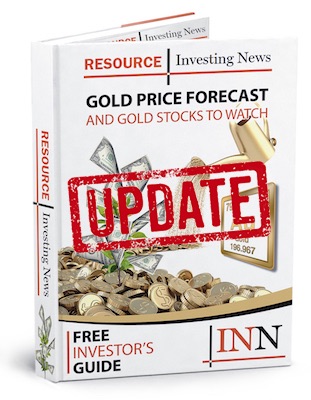“It’s been tough, it’s been rough,” says Chris Mancini. But now is the time to invest in gold.
Mancini, an analyst at Gabelli Asset Management (NYSE:GBL), explained on the sidelines of the recent Mines and Money conference in New York that he sees the yellow metal as “a hedge that’s necessary to have” in today’s world.
In particular, he pointed to the current levels of debt in the economy and “what’s been happening in terms of central bank intervention and monetary policy” as concerns.
At Gabelli Asset Management, Mancini helps run a number of funds, focusing mainly on precious metals miners. When asked if now is a good time to get into gold stocks, he said yes — with a caveat.
“I think that there’s a lot of value right now, so if you’re a very patient investor and you have … the stomach to weather some potentially pretty severe volatility, I think you will be rewarded,” he said.
Watch the interview above for more insight on gold and gold stocks from Mancini. You can also read the transcript below.
INN: We’re here at Mines and Money, and this the first time that we’re talking. Can you start by telling me a little bit about yourself and what you do at Gabelli Asset Management?
CM: Sure. I am an analyst at Gabelli Asset Management, I follow mining companies. Gabelli is a New York Stock Exchange-listed company, it has around $43 billion under management. Primarily it’s value investing led by a team that’s led by Mario Gabelli, the founder of the firm.
Within that $43 billion there are couple funds, which are gold- and natural resource-oriented funds. There is a $300-million open-end gold fund called the Gabelli Gold Fund, and then two closed-end funds, which are income funds. I focus on mining companies, primarily precious metal mining companies, and I help manage those funds, including the open-end gold fund.
INN: Earlier today you participated in a panel here focused on gold — what is your view on gold so far this year? Has it performed as you expected or were there surprises for you?
CM: So far it’s performed pretty much as I have expected. There has been — what happen last year was that I thought that the yield curve was going to actually start to invert. And I thought what was going to happen was that as interest rates rose, the market was going to see that it wasn’t sustainable … because there’s too much debt in the economy. And the yield curve was starting to invert into the end of the year.
What happened was that the big tax bill was passed, and that was a huge form of stimulus for the US economy that essentially is bringing growth forward right now. It’s a trillion dollars of tax cuts in all, and it’s gotten the economy juiced right now for the first half of the year, probably for the rest of the year. And that’s going to allow the Fed to raise rates without necessarily having as big of an impact on the economy as they otherwise would have had without the effects of this big stimulates in the form of tax rates. So the yield curve is not as close to inverting now as it was it the end of last year.
Ultimately at the end of the day I think it’s going to take an inverted yield curve to cause the gold price to really rally. So as long as we’re feeling the effects of this stimulus I think that gold will probably be range bound. Once the effects of the stimulus wear off and then the economy has to deal with and adjust to higher interest rates, I think the yield curve again is going to start to invert and gold’s going to do a lot better.
INN: So that’s really what we need to see to have gold move higher. What about geopolitical issues and things like that that people also look at in terms of gold?
CM: I think geopoliticals can have an affect, I think that at the end of the day, what gets gold to move higher is really supply and demand based on individuals wanting to own it as a hedge against currency debasement. That currency debasement could come from the risk that a government repossesses bank accounts, it could come from the risk that they’ll be some kind of bombing campaign or an actual invasion of a certain country.
For example if there were risk in South Korea that North Korea were to actually, God forbid, invade South Korea, then South Koreans would probably go and buy lots of gold. I don’t think that risk is extremely high right now, and despite all the rhetoric that’s taken place over the past year or so, I don’t think that risk has really ever been over the past year that high. So again, I think that geopolitical risk can play into the gold price, but at the end of the day it’s really going to take effect if there is physical demand from a country in which that geopolitical risk is talking place.
INN: You mentioned the Fed — how many rate hikes do you think we’re looking at for 2018?
CM: I think that we’re going to have a couple more this year. I think the Fed is going to keep raising rates according to their schedule, and I think again they’ll be able to raise rates according to their schedule because we’ve had this really big stimulus in the form of tax cuts. I think this year it’s really going to go as planned. And then next year, again once the effect of …read more
From:: Investing News Network

